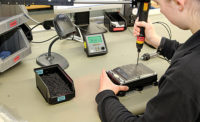One of the challenges in testing wire harnesses is maintaining control of the testing process. Typically, the testing process for wire harnesses is not fully automated. Operators manually connect and disconnect wire harnesses from the test fixture. After a wire harness has been tested, it must be categorized as having passed or failed, and the operator must segregate failed harnesses from good ones.
At times, an operator may fail to properly segregate a failed wire harness, causing significant problems downstream. Another potential problem occurs when an operator fails to wait until the test is completed and removes a partially tested wire harness from the test fixture. Selecting the wrong test program is also a potential problem.
Fortunately, wire harness manufacturers have several options to help them control the testing process and minimize the possibility of intermingling defective harnesses with good ones. These methods include:
- Activating a fixture clamp when the wire harness has passed all tests.
- Printing a label only when the wire harness has passed all tests.
- Sounding an alarm if the operator removes the wire harness before the test is completed.
- Ensuring that the operator cannot alter the test program.
Fixture Clamps
Many high-volume manufacturers use fixture clamps to prevent the operator from removing the wire harness before the tester has verified that all tests have passed. In this scenario, a defective wire harness can only be removed from the fixture through intervention of a supervisor or other authorized personnel. This results in improved quality control.
A fixture clamp is a device that locks a connector in place while the wire harness is being tested. Most fixture clamp designs use a mechanical locking device that engages when a connector is inserted into a holder. When all tests have passed, an electric solenoid is used to release the connector at the end of the test. It is best to use fixture clamps that are closed and held by a mechanical latch and are opened by activation of an electrical solenoid. This ensures that the clamp will remain closed even if the power is disconnected.
It is important for the tester to be able to activate the solenoid via a control port. This is how the process would work:
When the operator inserts the wire harness connector into the fixture block, the connector is mechanically locked in place.
When the wire harness passes all tests, the tester activates the solenoid, which releases the harness connector.
If the wire harness is defective, and cannot be repaired, a supervisor or other authorized person can use a security override procedure that releases the fixture clamp, allowing the defective wire harness to be removed from the fixture.
Printing a Label
Some harness testers can be programmed to interface with a label printer. The tester can trigger a product label to be printed when a wire harness passes all tests. This is superior to using preprinted labels. Using the tester to print a label when a wire harness passes all tests ensures that only good products receive labels. This assurance does not exist when using preprinted labels.
Using the tester to print labels also allows for dynamic data to be part of the label information, such as the date and time, operator identification and tester identification. When only good wire harnesses get labels, it simplifies the process of segregating good product from bad.
Sounding an Alarm
Some wire harness testers can be programmed to go into alarm mode when a harness is removed from the fixture before unit has completed testing. While in the alarm mode, the tester would do the following:
- Stop testing.
- Sound an audible alarm.
- Display a message indicating early removal of the harness.
- Require activation of a security override by a supervisor or other authorized personnel to deactivate the alarm.
- It is important that the alarm mode cannot be cleared by cycling power on the tester.
- Safeguarding Test Programs
To prevent problems associated with running the wrong test program, the tester must be able to prevent unauthorized personnel from selecting the test program. This ensures that once the right test program has been selected, the operator cannot alter the selection.
Using one or more of these approaches can enable wire harness manufacturers to improve quality control of their products. A wire harness tester that can support these capabilities is vital for error-proofing the testing process.
For more information on harness testing, call 800-SOS-DYNA or visit www.dynalabtesters.com.





